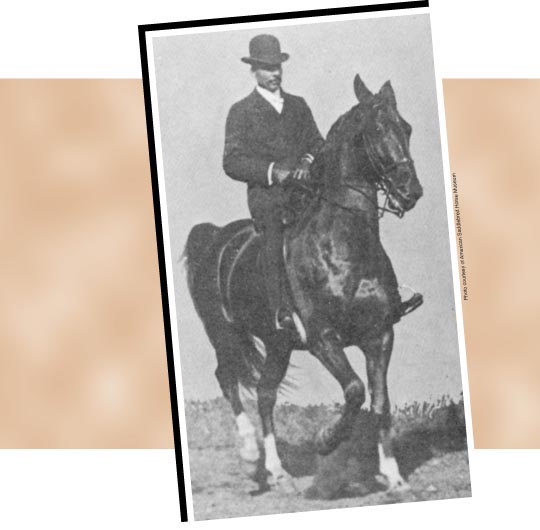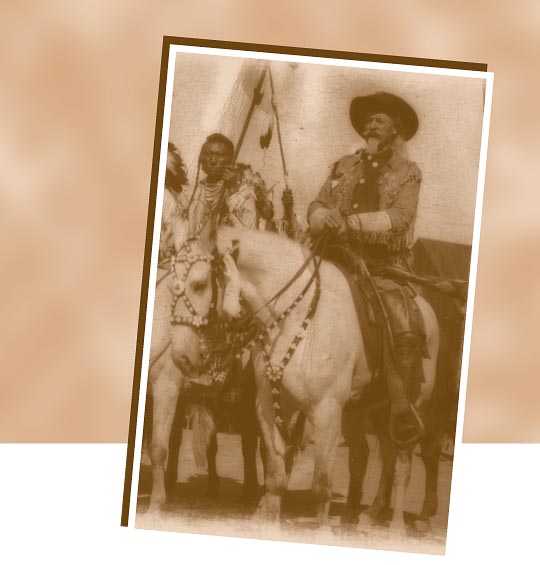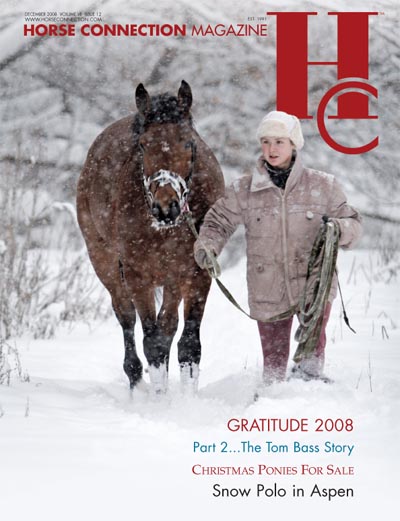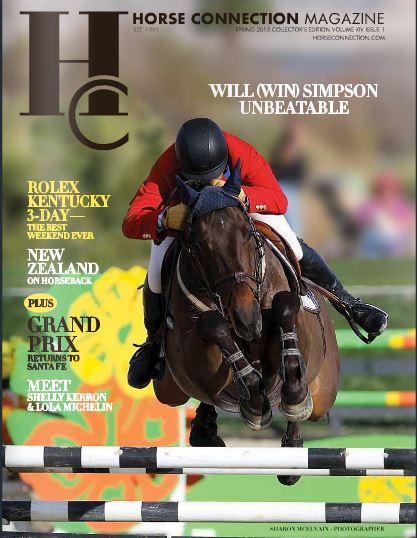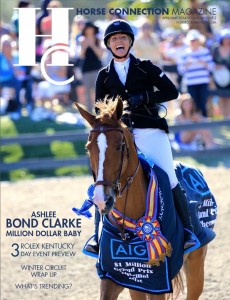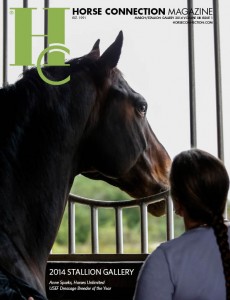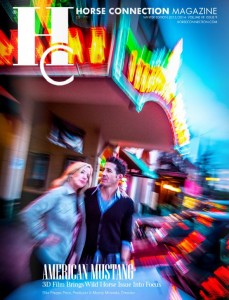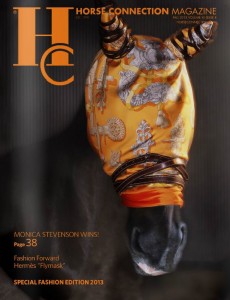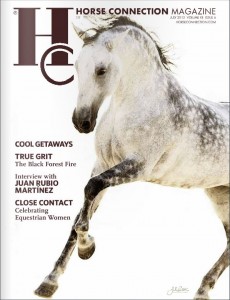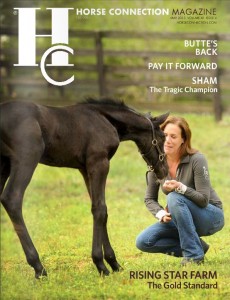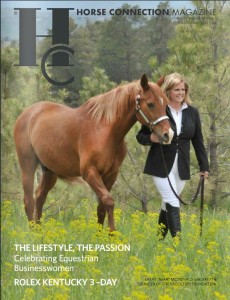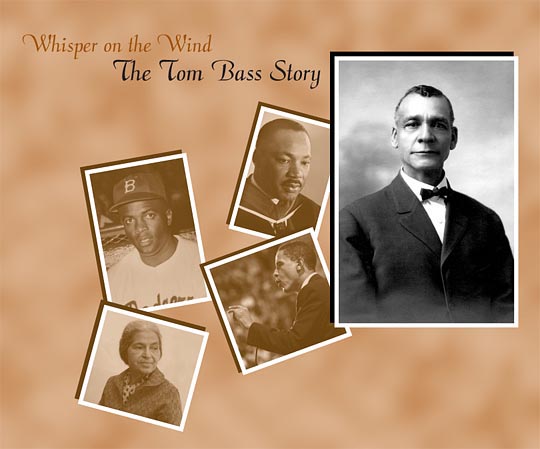
Whisper on the Wind – The Tom Bass Story Part 1
 Whisper On the Wind – The Tom Bass Story
Whisper On the Wind – The Tom Bass Story
CuChullaine O’Reilly FRGS
Read part two of this story here!
It was the Golden Age of the American horse. The hayrides, sleighing parties, buggy drives, circus parades, and proud cavalry drills that have now passed into legend were everyday equestrian events then. Literature was influenced by the activities of Theodore Roosevelt, Rough Rider, president and devoted horseman. Paintings by contemporary artists of the time with names like Charles Russell and Frederic Remington reflected the legend of the American West. Popular songs enshrined “jingle bells” and “old paint.”
The horse reigned supreme and every able-bodied American, man or woman, boy or girl, regardless of race, was in contact with the American horse in one form or another. They plodded across the Pennsylvania farm on Old Dobbin, raced towards the Montana horizon on a half-wild Cayuse or took the air around Central Park behind a matched team of high-steppin’ Cleveland Bays. No matter. God’s noblest gift to man, the horse, was King.
In such an environment every one naturally rode. Human nature has changed very little in only one hundred years. Then as now, what you rode said a great deal about your social status. Before anyone ever imagined the words Lexus or Rolls Royce, Americans were arguing the finer points of Narragansett Pacers versus Chickasaw ponies.
All Americans, red, yellow, white and black rode. Then as now some of them rode better than others.
In such an age, among so many horsemen one man stood out. His legendary ability to “talk” to horses was the buzz of the nation. In a world of horseplayers, he was the equestrian Mozart.
Before Jackie Robinson ever donned a Dodger uniform – there was Tom Bass. Before Rosa Parks ever demanded a seat in the front of the bus – there was Tom Bass. Before Martin Luther King ever had a dream – there was Tom Bass. Before Barack Obama ever ran for President – there was the legend of Tom Bass – the black horse whisperer.
Born a slave, the friend of Presidents, the most famous Black American horseman this country has ever known, today his story is consigned to oblivion. Yet once his name was a household word synonymous with equestrian feats of unparalleled beauty and achievement.
But he didn’t start out famous. He started out in chains.
SLAVE CHILD
The year 1859 was a bad time to be born black. And few places were more unlikely to harbor a hero than the tiny Missouri slave cabin where Tom Bass first drew breath and cried out that cold January morning. His mother Cornelia Grey tried to comfort the infant. Despite the fire her father had laid on, the place was freezing. There was little comfort to be had. Besides, she was a slave on one of the largest plantations in the state. She suckled the infant and held him tight against the penetrating cold.
Little Tom Bass had even less paternal support.
His daddy was not present at the blessed event, which came as no surprise to Cornelia. William Hayden Bass wasn’t just newborn Tom’s father, he was white, and therefore also the child’s legal owner. According to the laws of Missouri, Bass was allowed to either sell off or keep his own child as he saw fit. But there were hundreds of slaves on the Bass plantation and a civil war with the North was looming. Little Tom snuggled up against his mother, ignored for the time being by both his father and the cold, cruel world outside. He was just another commodity on an otherwise busy plantation.
It was Grandpa Presley Grey who raised the boy soon after his mother left home. The Civil War raged around them, with men fighting and dying on battlefields like Shiloh and Gettysburg. And though troops came and went the Bass plantation remained intact.
Illegitimate, ignored, suspect in both worlds, it came as no surprise to Grandpa Presley that even as a child Tom preferred horses to people. Tom learned to toddle while playing around horses so tall he could walk under their bellies. The little boy was riding alone at four. Two years later he was jumping fences fearlessly. Horses started following him around the barnyard like 1200-pound lap dogs. Folks on the plantation couldn’t help but notice the boy’s uncanny ability to communicate with animals.
When the fate of the nation was decided at Appomattox by Grant and Lee, the slave system in Missouri was abolished. Tom Bass was a free man at the age of six. His Grandpa Presley had waited more than fifty years to savor the same moment. But with no money, no prospects and no where else to go, Grandpa Presley decided to stay on at the plantation working as a freed man. Little Tom did likewise.
MR POTTS
Though he later owned some of the most famous horses in the world, Tom Bass started out on a humble mule. Grandpa Presley had given him the notorious Mr. Potts to train as he saw fit. The mule was infamous for his refusal to work. He couldn’t be hitched to a wagon. Plowing was beneath him. Riding him was out of the question. It was either sell him off or give him to the beloved grandchild to fool with. He went to Tom.
Like many of the other challenges that confronted Tom Bass later in life, his first unofficial horse show came about because of bigotry and racial prejudice. When Tom’s half-brother, the white son of William Hayden Bass came back to the plantation, fate intervened. The brother and his friends were clumsy riders. When they noticed Tom watching with an amused smile they mocked him, calling him racial slurs and daring him to prove he could outride them. History was about to be made.
In a few minutes Tom reappeared wearing his Grandpa Presley’s black coat and white shirt. The clothes were too big. But what sent the white boys off into peals of laughter was seeing Tom leading out the outlaw mule Mr. Potts. They continued to laugh as he mounted but then their mockery came to an end. Mr. Potts was going around the ring in a fine collected canter. Mr. Potts was racking like some fine saddle horse. Then Mr. Potts did the impossible. He cantered backwards around the length of the ring. Mr. Potts the outlaw was no more. Tom Bass, his trainer, was nine-years-old.
MEXICO, MISSOURI
Tales began to spread among the backwoods of Missouri about a small black boy who was making miracles happen with horses. Tom’s first job was at the town hotel. Originally hired to simply drive customers from the train station to the Ringo Hotel, it wasn’t long before the teenage boy’s uncanny ability to solve equestrian problems was the talk of the town. Well-to-do white customers were soon bringing him horses that no else could ride or train. When not busy working as a bellhop and buggy driver, he began turning out high-stepping horses on the side.
By the spring of 1879, at age 20, Tom had been hired to work as a trainer by Joseph Potts, in the nearby town of Mexico, Missouri. Potts was one of Missouri’s leading horsemen. He owned Thornton Star, one of the founding stallions, of the yet to be recognized American Saddle Horse. Pott’s business partner, Cyrus Clark, expressed what many in the burgeoning town felt, that the class conscious saddle horse business was no place for a black man. Joseph Potts strongly disagreed, arguing he had never met a man who had a better eye for horseflesh than Tom Bass.
The American Saddle Horse was entering its Golden Age. High-stepping prancers ruled the road. Men were judged as much on what they rode as who they were. The Mexico Horse Sales Company, owned by Potts and Clark, prided itself on selling only the “Cadillac’s” of the horse world. Exceptional horses for the company’s annual sale were always in demand. When that year’s highly anticipated summer sale rolled around, the company was facing a shortage of suitable horses to offer at the horse sale. Tom surprised his employers by producing six “back country bargains,” for the company to sell. Even cynical Cyrus Clark had to admit that Tom had quietly taken these six outlaws and returned them “lady broke.” Potts just nodded wisely and told his bigoted partner that Tom Bass was the best judge of horseflesh he had ever met.
THE TOM BASS BIT
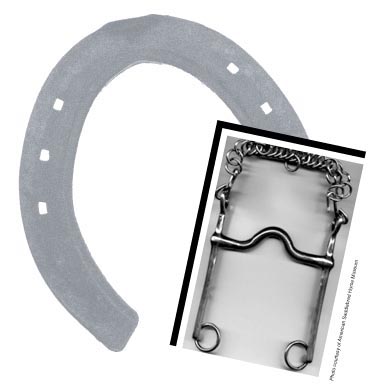 During these formative years Tom earned an unequaled reputation for treating horses with kindness that lasted his lifetime. Many Americans were still inclined to see horses as disposable commodities, to be used cruelly, fed as little as financially possible and when they died horribly, worked to death in their traces, to be swiftly replaced by a new equine victim. The recent Civil War had been instrumental in beginning to change this common misconception. Men who had suffered and campaigned alongside their equine companions were less apt to beat and ride them to death. Cruel practices were still common however, one of which was to severely overbit a horse and then to brutally punish it when the horse reacted against the torment in its mouth.
During these formative years Tom earned an unequaled reputation for treating horses with kindness that lasted his lifetime. Many Americans were still inclined to see horses as disposable commodities, to be used cruelly, fed as little as financially possible and when they died horribly, worked to death in their traces, to be swiftly replaced by a new equine victim. The recent Civil War had been instrumental in beginning to change this common misconception. Men who had suffered and campaigned alongside their equine companions were less apt to beat and ride them to death. Cruel practices were still common however, one of which was to severely overbit a horse and then to brutally punish it when the horse reacted against the torment in its mouth.
Still in his early twenties, Tom Bass quietly invented a new bit, which revolutionized the horse world. The majority of bits at the time were light, with low ports and short shanks. Tom’s observations of problem horses convinced him that ill-fitted, improper bitting was largely responsible for bad backs, lameness and much of the savage behavior he encountered in equine outlaws. The customer’s strong demand for road worthy horses in a hurry was forcing many trainers to rush the horse’s training. Horses were fighting the cruel bits forced into their mouths, being whipped and even clubbed when they resisted.
Bill Cunningham, a friend recalled years later that, “Tom’s idea was to use the bit to communicate to the horse instead of punishing him. He concocted a bit with a high port and a seven-inch shank that was a little heavier than the old fashioned ones. His bit just nipped the roof of the horse’s mouth a little. This kept the horse from the taking the bit in his teeth and the rider having to whip him. It was a humanitarian idea.”
When presented with the new bit, Joseph Potts urged Tom to patent his new invention. Tom replied that he had stayed awake at nights worrying about the welfare of the horses of the world. He didn’t want any money for his new bit. He just wanted to ease the suffering of horses. Known as the Tom Bass Bit, it was soon widely copied, though few people knew who its originator was.
TOM RIDES INTO HISTORY
Two years later Tom Bass not only surprised his employers, he made history. A man-killing mare, “The Blazing Black,” had been brought into the stable to either be trained or destroyed. She was so vicious, kicking, screaming and biting, the terrified stable hands had to drive her into a stall with a pitchfork, before they could manage to slam shut the stall door. The next few days, while the other men went about their chores, Tom began quietly working the mare, always softly talking, talking, talking to the contentious animal. He cautiously gained her trust, slowly touching her withers, her head, and her feet. For the first time in her life she was treated with respect instead of cruelty.
Joseph Potts and the crew were shocked two nights later when Tom Bass came riding softly into the stable on the killer horse. Potts later swore that Tom had not only made them forget she was an outlaw; he had even convinced the horse of it.
When Potts asked Tom why the mare hadn’t tried to kill him like everyone else in the barn, Tom replied, “If she was going to kill me she would say so.”
A few months later, with an important horse show coming up, the Mexico Horse Sales Company now found themselves facing a new dilemma. They did not have a mare to compete in the prestigious event. Winning showhorses meant improved horse sales. The company was in the embarrassing position of not having a show-worthy mare. Spurning the whip and relying instead on his intuitive sense of communication, Tom Bass had managed to do wonders with the Blazing Black. Yet she would allow no other rider or groom close to her.
As long as Tom was on her back, the Blazing Black was show quality. But Tom Bass was not white and no one else could ride her.
When the faithful day arrived to either show the mare or face the specter of professional defeat, Joe Potts announced to his partner and the other company employees, “I hope you’re ready Tom Bass, because you are about to be the first Negro in history to show the Missouri and Kentucky white folks that a good man on a fine riding horse can perform a miracle.”
It was a turning point in the life of the young horse trainer.
When the time came to ride into the class for mares, four years and older, a nervous Tom remembered what his Grandfather Presley had told him, “You got to be fearless son. Our people need your success.”Word had quietly spread among the twenty or so other riders in the class that Potts and Clark were entering Tom in the class because he was the only one who could ride this outlaw mare. There was some curiosity but no hostility. Tom rode the Blazing Black confidently, quietly took second place and broke down a long cherished color barrier which held that riding quality show horses was an activity reserved for America’s white gentry.
Potts was furious, believing Tom had deserved to win the blue ribbon. But Tom was pleased, believing he had shown that his skill in riding was more important than the color of his skin. It soon became a point of honor among other riders to beat him in the show ring. Few of them could.
ON HIS OWN
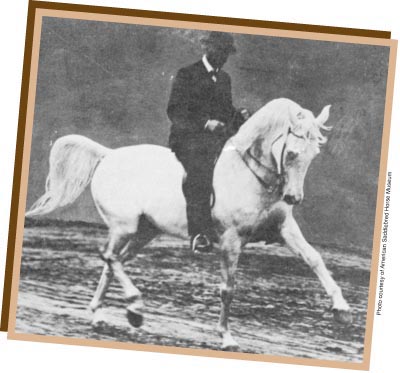 In 1883 the Mexico Horse Sales Company was sold. Taking the advice of his mentor Joe Potts, Tom took the courageous step of starting his own training stable. He bought four brush-covered acres on the outskirts of town. A local contractor offered to clear the land if, in exchange, Tom would train his team of horses, who were notoriously afraid of locomotives. Tom blindfolded the two horses, led them onto a train car and took them to the Kansas City stockyards, where trains in the nearby terminus came and went all night. By the time they arrived back home in Mexico, Missouri late the next day, the two train-weary horses were ready to go back to work.
In 1883 the Mexico Horse Sales Company was sold. Taking the advice of his mentor Joe Potts, Tom took the courageous step of starting his own training stable. He bought four brush-covered acres on the outskirts of town. A local contractor offered to clear the land if, in exchange, Tom would train his team of horses, who were notoriously afraid of locomotives. Tom blindfolded the two horses, led them onto a train car and took them to the Kansas City stockyards, where trains in the nearby terminus came and went all night. By the time they arrived back home in Mexico, Missouri late the next day, the two train-weary horses were ready to go back to work.
Life took on a faster pace.
Tom married Angie Jewell, the town’s first black school teacher, in 1882. They built a house, raised a barn and laid out training rings.
Word of Tom’s ability with horses was now spreading throughout Dixie. He was still riding in horse shows and bringing home blue ribbons. In 1888 the governor of Missouri sent his horse to Mexico to be trained by Tom Bass. Business was soon booming and Tom confided to Angie that he had a new concern. He needed a brag horse.
COLUMBUS
Like all great show stables of that day, Tom Bass wanted a superior horse he could ride in horse shows. A great winner meant more horse sales and training for the Bass stables. One day Tom came home trailing his brag horse. A long legged gray colt pranced behind his buggy.
“Found him in a field full of cows and bought him for $100. He’s got the fastest moves I ever saw on a colt,” he told Angie and went on to inform her he had named the colt Columbus. When asked why, he replied, “Columbus discovered America and I discovered Columbus.”
Tom was delighted when Columbus learned to obey voice commands easily. The young horse followed Tom around any maze of obstacles, displaying an absolutely fearless nature. Any gate he couldn’t open with his teeth, he would crawl under. Tom swore he was the smartest horse he had ever known or heard of. The young gray soon became more like Tom and Angie’s child than just another horse in training. During the next few years, while working other people’s horses, Tom devoted as much time as he could to Columbus. By the time Tom decided Columbus was ready for his first show, the gorgeous gray gelding was picture perfect with arching neck and flashing eyes.
THE CENTAUR
Tom Bass already had a reputation as a fine trainer, a gentleman both in and out of the ring and a rider of unbelievable ability. Many initial critics had long ago learned that think what they might privately about his origins, in the show ring Tom Bass was almost impossible to beat. His uncanny talent of gently communicating with his horses seemed to bring forth responses from his mounts that left other riders looking like rank amateurs.
But due no doubt to Columbus’s own amazing natural talents, Tom decided their maiden show together had to be a big one. He entered them in the St. Louis horse show. The event attracted the best talent the Midwest had to offer. General Ulysses Grant and other equally famous horsemen had shown their horses there. It was also a meeting place of the socially powerful. No black American had ever had the opportunity to ride there. Until Tom Bass showed up with Columbus, no black American had ever had the courage to even try.
Tom entered Columbus in the High School competition. This complicated class was considered the most difficult of its time. Each horse entered the ring and performed his routine alone to the music of a St. Louis band. The Spanish Trot and the Caprice were only a few of the movements expected of horses deemed worthy of the honor of competing in the High School event.
When the ringmaster called out “Thomas Bass showing Columbus,” the eyes of the American Midwest were riveted on the young rider. Whispers flew. What was a black man doing in the show ring? Wasn’t this the fellow rumored to have taught all those outlaw horses? But the questions ceased when Tom and Columbus started their routine.
The music flowed and the great gray horse flew.
He and his rider pirouetted. They pranced. They racked. They pivoted and leaped.
The crowd hushed as they watched an equine performance the like of which none of them had ever seen. Tom rode Columbus as though the two of them had issued together from the same mother’s womb. They were half horse, half man, a perfect blameless centaur who had passed into perfection and left behind this world of tears.
Then Tom put to rest the legends. Columbus cantered backwards around the show ring.
The performance was so faultless even the other contestants began to applaud.
Finally Columbus stood on his rear legs, turned a full circle and then with the grace of a ballerina, came down to kneel on one leg, bowing his head in tribute to the astonished judges.
“I’ll be damned,” one judge was heard to say. “I would have said that was an impossible feat for any horse or horseman.”
Tom Bass, backwoods horseman had taken the world by storm.
AN UNEXPECTED GUEST
Coveted blue ribbon in hand, the triumphant Tom Bass returned home to Angie and Mexico, Missouri. His business prospered as never before. His list of celebrity clients grew. Life was looking good for the little boy born in a slave cabin.
Then one day Angie sent word to Tom to hurry home. They had an unexpected guest who had come to discuss business. The grooms and trainers Tom employed were working well. Glancing down the barn he saw Columbus looking contented in his stall. Tom could afford to take a few minutes away from the daily routine. Hurrying to the house, he came through the kitchen door where he found a visibly nervous Angie, anxiously awaiting his arrival. She pointed silently to the parlor.
Walking in he saw a man with his back turned towards him, busy studying some of the hundreds of blue ribbons Angie had displayed in the glass fronted china cabinet. Hearing Tom enter, the man turned. He was tall, rail thin, a horseman by the looks of him. His hair hung down to his shoulders, frontier style. A massive mustache hid a generous mouth, while a proud goatee shot off the end of a strong chin. He looked vaguely familiar. Before Tom could ask the stranger his name, the other man shot out a hand in greeting.
“Mr. Bass, I’m Buffalo Bill Cody and I’ve come hoping to buy Columbus for my Wild West Show.”
For more information on Tom Bass visit the Audrain County Historical Society atwww.audrain.org



